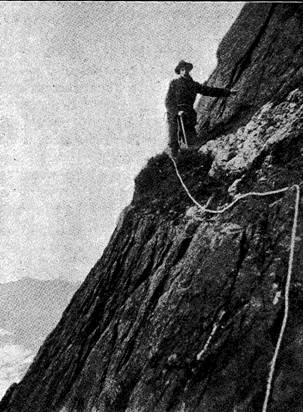A New Route Up Slanting Gully, Lliwedd
By Fred Botterill
Those who possess Haskett Smith’s little book, “Climbing in the British Isles, Wales and Ireland,” will, if they turn to pages 85-87, read a short history of the early attempts to ascend Slanting Gully. In the accounts therein, parties appear to have been ultimately turned back at the 70 ft. chimney above the cave, and it was from near the top of this, as far as I can make out, that Mr. J. Mitchell of Oxford fell and lost his life in 1894.
In the account of the attempt made by Messrs. F. O. W., C. W. N., E. H. K., and H. K., on January 9th, 1894, it says:- ” With longer time at disposal it seemed possible that this difficulty might have been surmounted by wriggling up inside the crack, or by a dangerous scramble on the face of the slab.” Both of these have since been climbed. The first complete ascent was made in 1897 by the brothers Abraham of Keswick, who after reaching the top of the 70 ft. chimney or crack kept to the gully all the way.[1] I have no record of the second ascent; but what is believed to be the third ascent was made on the 18th June, 1902, by a party composed of Messrs. H.L. Jupp, J.V. Brett, J.H. Phillips, and A.E.W. Garrett. This also was made by the chimney.
On the 17th of June last my brother Matthew and I started for a cyclo-mountaineering tour in N. Wales. We had heard a report of the deplumation of Pen-y-gwryd Hotel as a climber’s resort and decided to seek accommodation elsewhere. We found a very comfortable berth at the house of John Owen, Bron-y-graig, in the little village of Glanaber, Nant Gwynant, and failing Pen-y-gwryd or Gorphwysfa would recommend this village as a temporary climbing centre.
On Saturday, June 20th, 1903, at 3.45 p.m., we found ourselves at the foot of Slanting Gully with 80 ft. of rope, a light English axe, a hand camera, and a rucksack containing cooking outfit and eatables. We roped up and followed the ordinary route as far as the cave, finding no particular difficulty even with the rucksack and axe which I carried, M. not being in the best of form. Reaching the little grass ledge where the crack overhangs the cave I put down my impedimenta and mounting on M.’s shoulders tried the crack. It would not go, and after fumbling about for a time my companion politely asked to be allowed to let me down as the extra big nails in my boots were making serious impressions on his shoulders. I then invited him to mount on my shoulders, or on my head if he found that necessary, and try and discover a way. He tried bravely for some time but without success, and after a short rest I turned my attention to the slabs on our left.
There is a conspicuous white quartz vein about 8 inches thick which runs horizontally above the grass ledge, and after traversing to the left of the crack for about 10 ft. I was able to stand on the quartz and obtain a full view of the slabs. Here a way was visible, and before rejoining M. I had made up my mind that it would go. Meanwhile M. had found a suitable belaying pin, so after paying special attention to the knots of our rope I left the axe and rucksack with him and returned to my standing place on the quartz vein. Ascending obliquely away from the crack for about 15 ft., I reached a distinct line of holds up the slabs, and advanced slowly up these until my companion shouted and warned me that only 8 ft. of slack rope remained. I was still 18 ft. from my objective and looked around me for a possible resting place. There was none, so further advance was made until the cry came that all the rope was out. I was then on a projecting piece of rock, the top of which formed an equilateral triangle a little over 1 ft. each way. On this I sat while M. unroped and tied on the rucksack and axe, which I dragged up; then finishing the climb, my burden was deposited on the terrace – a narrow grass ledge leading back to the top of the chimney. When about to return to the triangular rock I observed that it might be possible to stand over the chimney and throw the rope down direct. This proved correct. M. then came up, resting half way, and commenting on the difficulty he was experiencing.The climb was finished in the ordinary way and we came out at the cairn at 7.20 p.m. A cairn was built above the chimney and a long piece of rock placed upright over our route.
At least 80 ft. of rope is absolutely necessary for this climb. The route up the slabs is singularly like the Eagle’s Nest. The handholds are very similar, and the triangular rock though rather less comfortable, may be likened to the Eagle’s Nest Ridge (difficult way) on the Great Gable. The total difficulties of the two climbs are much about equal.
By the discovery of this route the ascent of Slanting Gully will, we think, be made a little easier than before.
